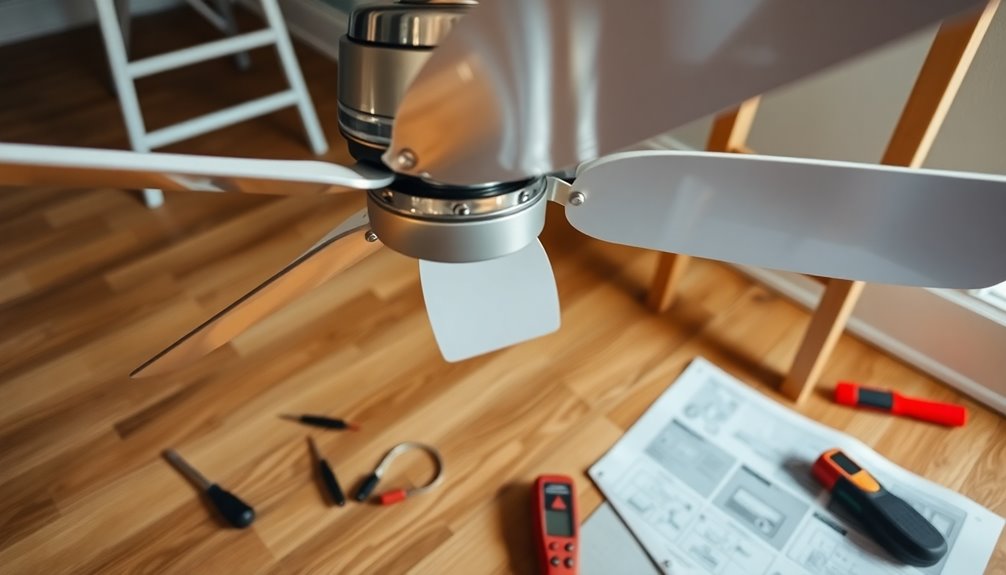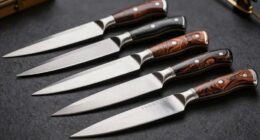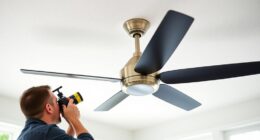When choosing a light bulb for your ceiling fan, you're typically looking at wattages between 6W and 60W, depending on the fan's age and specifications. Newer fans usually support a maximum of 60W, while older models can go as high as 180-240W. LED bulbs are ideal since they're energy-efficient and long-lasting. Always check the manufacturer's guidelines to avoid overheating or fire hazards. Remember that brightness isn't determined by wattage alone; consider lumens for effective lighting. If you want to create the perfect atmosphere, keep exploring other aspects of bulb selection and maintenance!
Key Takeaways
- Check the ceiling fan's manufacturer specifications for the maximum wattage allowed, typically ranging from 60W to 100W for newer models.
- Use LED bulbs for energy efficiency; a 6W LED can replace a 40W incandescent while providing similar brightness.
- Ensure compatibility with the base type of the ceiling fan, commonly E12 for smaller fixtures and E26 for standard sockets.
- Aim for brightness around 800 to 1600 lumens for effective general lighting in larger spaces.
- Regularly verify and replace bulbs according to recommended wattage limits to prevent overheating and hazards.
Understanding Bulb Types

When it comes to choosing bulbs for your ceiling fan, it's essential to sort through the different types available. You'll typically encounter incandescent bulbs, CFLs, and the increasingly popular LED bulbs.
While incandescent bulbs are commonly used, they're not the best option for ceiling fan fixtures due to their higher wattage rating and excessive heat dissipation. Using a higher wattage incandescent bulb can lead to overheating, which isn't ideal for your fan's safety and performance.
On the other hand, LED bulbs stand out as the most energy-efficient and long-lasting choice. A 6W LED bulb can replace a 40W incandescent bulb while still providing ample brightness. This lower wattage rating means you can enjoy a well-lit space without worrying about heat buildup.
When selecting bulbs, always check the manufacturer's specifications for your ceiling fan fixtures. This guarantees you stay within the recommended wattage limits and maintain safety.
Importance of Wattage Ratings

Understanding wattage ratings is essential when choosing light bulbs for your ceiling fan.
These specifications not only determine the maximum wattage your fixture can handle safely but also help prevent overheating and potential fire hazards.
Maximum Wattage Specifications
Knowing the maximum wattage specifications for your ceiling fan is essential for safety and efficiency. Each ceiling fan fixture typically has a specified maximum wattage limit that you must adhere to, often ranging from 60W to 100W for newer models.
Older models might support higher wattages, up to 180-240W. Ignoring these wattage limits can lead to serious safety risks, including overheating and potential fire hazards.
Before you choose a ceiling fan bulb, always check for labels near the bulb sockets or consult the instruction sheets for accurate wattage guidelines.
Using a bulb that exceeds the rated wattage can trigger safety mechanisms designed to protect the fixture, leading to damage or malfunction. Additionally, exceeding the manufacturer-specified wattage could void warranties and insurance coverage, leaving you unprotected against potential issues.
Safety and Overheating Risks
Using bulbs that exceed the specified maximum wattage can pose serious safety hazards, primarily through the risk of overheating. When you use a high-wattage light bulb in your ceiling fan, it can lead to overheating, which may increase the chances of electrical fires. Additionally, you could damage the fan's wiring and components, leading to costly repairs.
To guarantee your safety, keep these risks in mind:
- Exceeding the wattage limit can cause insulation on wires to deteriorate, heightening the risk of electrical failures.
- Many newer ceiling fans come with built-in wattage limiters, which help prevent overheating.
- Ignoring wattage ratings can void warranties and may affect your insurance coverage in case of fire damage.
Always check the wattage limits printed near the bulb sockets or in the instruction sheets. By sticking to the recommended wattage for your ceiling fan, you can greatly reduce the risks associated with overheating.
Compatibility With Ceiling Fans

When selecting a light bulb for your ceiling fan, it is crucial to guarantee compatibility with the fixture's specifications. The wattage of the bulb you choose must align with the manufacturer's recommendations, typically ranging from 40W to 100W for older models. However, newer ceiling fan light fixtures often accommodate energy-efficient LED bulbs, limiting maximum wattage to around 6W.
You also need to pay attention to the bulb base type. Common bases include E12 for smaller fixtures and E26 for standard sockets. Exceeding the recommended wattage can lead to overheating and even pose fire hazards, potentially voiding warranties or insurance coverage.
Here's a quick reference table to help you assess compatibility:
| Bulb Type | Maximum Wattage |
|---|---|
| LED | 6W |
| Incandescent | 40W – 100W |
| E12 Base | Check specifics |
| E26 Base | Check specifics |
Brightness and Lumens Explained

When you're choosing light bulbs for your ceiling fan, understanding lumens is key to achieving the right brightness.
Different spaces require different levels of illumination, so knowing how to match wattage with lumens can make a big difference.
Let's explore how to choose the appropriate brightness for your needs.
Understanding Lumens Measurement
Often overlooked, understanding lumens is essential for selecting the right light bulbs, especially for ceiling fans. Brightness is measured in lumens, and for standard ceiling fan bulbs, you'll typically find a range of 800 to 1600 lumens. The higher the lumens, the brighter the light output.
For general room lighting, aim for at least 800 lumens, particularly in larger spaces.
When choosing bulbs for your ceiling fan, keep the following in mind:
- LED bulbs offer significant energy savings while producing the same brightness as incandescent bulbs.
- Wattage alone isn't a reliable measure of brightness; for instance, a 6W LED can match the output of a 40W incandescent.
- Always check the manufacturer's wattage limitations to guarantee safety and performance.
Understanding how lumens work helps you balance brightness and energy efficiency in your home. By selecting the right lumens for your space and opting for energy-efficient LED bulbs, you can enhance your ceiling fan's effectiveness while keeping energy costs in check. Additionally, using effective air quality measures, like air purifiers, can complement your lighting choices by improving the overall ambiance in your home.
Importance of Brightness Levels
Brightness levels are vital in creating a comfortable and functional atmosphere in your home. When choosing light for the room, understanding lumens is key. A standard ceiling fan bulb typically produces between 800 to 1600 lumens, which is essential for adequate illumination. Additionally, using a ceiling fan with an integrated air purification system can further enhance the overall air quality in your living space. Proper illumination is also crucial for identifying edible varieties when foraging, ensuring you enjoy safe and delicious meals. Moreover, maintaining a comfortable indoor environment can be effectively supported by energy-efficient technology that reduces energy consumption.
To achieve optimal brightness, consider experimenting with different brewing methods of lighting similar to how various coffee brewing techniques can affect flavor. If you're lighting a larger space, you'll want higher lumen output to guarantee the area is well-lit, since a typical 60-watt incandescent bulb only provides about 800 lumens.
Energy-efficient bulbs, like LED lights and CFLs, can offer the same brightness while using considerably less wattage. For example, LEDs can provide up to 100 lumens per watt, making them a smart choice for reducing energy costs.
Additionally, consider the color temperature of your bulbs. Higher Kelvin values (5000K-6500K) create a brighter, more daylight-like appearance, which can enhance the perceived brightness levels in a room. Furthermore, adequate lighting can positively impact your mood and productivity, similar to how coffee enhances cognitive function.
Choosing Appropriate Wattage
Choosing the right wattage for your ceiling fan light bulbs is essential for achieving the desired ambiance and functionality in your space. When selecting bulbs, you'll want to take into account brightness, measured in lumens, and the type of bulb you're using.
For ceiling fan lights, wattage generally ranges from 6W for energy-efficient LED bulbs, which can produce brightness comparable to a 40W incandescent bulb, to a maximum of 60W for newer models.
To help you choose wisely, keep these points in mind:
- Check the fixture's wattage limit: Always adhere to the manufacturer's specifications to prevent overheating and fire hazards.
- Consider LED over incandescent: LED bulbs are more energy-efficient and generate less heat, making them a safer choice for ceiling fans.
- Brightness needs vary: Rooms requiring more light might need bulbs with higher lumens, ranging from 800 to 1600, ensuring ideal brightness.
Color Temperature Considerations

The right color temperature can transform your ceiling fan lighting and set the mood for any room. Color temperature is measured in Kelvins (K) and greatly influences the ambiance.
For a cozy atmosphere, consider warm white bulbs (2700K-3000K). If you want a brighter light similar to natural sunlight, opt for daylight bulbs (5000K-6500K). Cooler temperatures (3500K-4100K) work best in task-oriented spaces, while warmer tones are ideal for relaxation areas.
When choosing LED bulbs for your ceiling fan, don't overlook the importance of color temperature. Many LED options allow you to select different temperatures, enhancing functionality and mood.
Higher Kelvin values result in a brighter, more vibrant appearance, making your space feel more open and inviting.
For added flexibility, consider adjustable color temperature or smart bulbs, which let you customize your lighting based on activities or times of day.
Installation and Safety Tips

When installing light bulbs in your ceiling fan, always prioritize safety to avoid accidents or damage. First, check the manufacturer's specifications for the maximum wattage allowed for your ceiling fan. This guarantees you don't risk overheating or creating potential hazards.
Next, use bulbs that match the base type of your ceiling fan fixture—typically medium (E26) or candelabra (E12). Proper installation is vital for both functionality and safety.
Before you start, make certain the power is turned off to prevent electrical shock or damage to the light kit. Here are some essential safety tips:
- Inspect the ceiling fan and its wiring for any signs of wear or damage.
- If you're unsure about wattage limits or bulb compatibility, consult a licensed electrician.
- Always handle bulbs carefully to avoid breaking them during installation.
Maintenance and Care Advice

Maintaining your ceiling fan is essential for guaranteeing its longevity and peak performance. Start by regularly dusting the fan fixtures to prevent buildup that can hinder airflow and affect aesthetics. A simple wipe-down keeps your fan looking great and functioning properly.
Perform periodic inspections of the wiring to check for any wear or damage. This not only guarantees safety but also assures that your ceiling fan operates efficiently. If you notice any issues, address them immediately to avoid further complications.
It's important to replace burned-out bulbs promptly to maintain adequate illumination and prevent strain on the fixture. Always check the recommended bulb wattage to confirm you're using the correct type for maximum brightness and safety.
For cleaning, use appropriate cleaners on glass or acrylic components to enhance the light's brightness and overall appearance.
If your fan is complex or you're unsure about maintenance, consider scheduling professional maintenance. They can effectively address potential issues and guarantee long-term reliability, giving you peace of mind and a fan that works beautifully for years to come.
Frequently Asked Questions
What Is the Best Wattage for Ceiling Fan Bulbs?
When choosing the best wattage for your bulbs, consider energy efficiency and safety.
Ideally, you'll want to stick to lower wattage options, typically between 6W to 15W for LED bulbs, which provide adequate brightness without overheating.
Always check your fixture's labeling to verify you're within the maximum limits.
How Do I Know What Light Bulb I Need for My Ceiling Fan?
To find the right light bulb for your ceiling fan, start by checking the fan's specifications.
Look for any labels near the bulb sockets that indicate wattage limits and compatible bulb types.
You'll also need to identify the bulb base type, like E12 or E26, to guarantee a proper fit.
For energy efficiency, consider using LED bulbs, as they provide brightness without consuming as much energy.
Adhering to these guidelines helps prevent overheating.
Can I Put a 60 Watt Bulb in a 40 Watt Ceiling Fan?
You shouldn't put a 60-watt bulb in a ceiling fan rated for 40 watts.
Doing so can cause overheating, posing fire risks and potentially damaging your fixture.
It's essential to stick to the manufacturer's specifications to guarantee safety and maintain functionality.
Using a bulb that exceeds the wattage limit can also void warranties.
Always check the fan's rating and opt for a lower wattage bulb to keep everything running smoothly and safely.
What Wattage Is a Standard Ceiling Light?
Imagine you're in a cozy 1950s diner, and the light's just right.
A standard ceiling light usually uses bulbs rated between 60 watts and 100 watts for most rooms.
You'll find that many modern fixtures come with wattage limiters, often capping at 60 watts for safety.
Always check the fixture's label to avoid overheating or fire hazards.
Keeping within the recommended wattage guarantees your lighting stays safe and efficient.
Conclusion
Choosing the right wattage for your ceiling fan's light bulb is like finding the perfect key to access a cozy atmosphere in your home. It brightens your space just right, creating a warm embrace for family and friends. By understanding bulb types, brightness, and safety, you can illuminate your world effortlessly. So, as you select that ideal bulb, remember—you're not just lighting a room; you're casting a glow on the moments that matter most.









